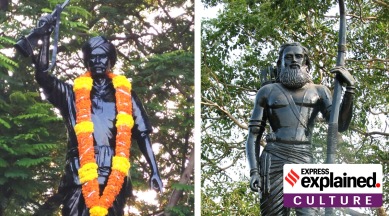‘RRR’ Oscars win: Who were Alluri Sitharama Raju and Komaram Bheem, whose stories inspired RRR
Both Raju, who is played by actor Ram Charan in the film, and Komaram Bheem, played by Jr NTR, were 20th century revolutionaries who led tribal people in present-day Andhra Pradesh against the British and the Nizams. Here is their story.

With a win for Best Original Song for ‘Naatu Naatu’ at the 2023 Oscars, the Telugu movie ‘RRR’ is garnering attention on the global stage. Its story and characters have roots in real historical figures, inspired by the lives of Indian freedom fighters Alluri Sitharama Raju, who is played by actor Ram Charan in the film, and Komaram Bheem, played by Jr NTR.
Both men were 20th-century revolutionaries who led tribal people in present-day Andhra Pradesh against the British and the Nizams. Bheem was a tribal man but Raju was not. Both leaders died young while resisting colonial rule.
Director SS Rajamouli said earlier that the idea for his film came from ‘The Motorcycle Diaries’, which depicts the life of Argentine revolutionary Che Guevara before he became well-known. ‘RRR’ shows the two freedom fighters’ lives and friendship in a fictionalised manner, as there is no record of them ever having met in real life. The film spans the period before they joined the freedom struggle.
Who was Alluri Sitharama Raju?
Raju is believed to have been born in Andhra Pradesh in 1897 or 1898. He is said to have become a sanyasi at the age of 18 and gained a mystical aura among the hill and tribal peoples with his austerity, knowledge of astrology and medicine, and his ability to tame wild animals.
At a very young age, Raju channelled the discontent of the hill people in Ganjam, Visakhapatnam, and Godavari into an effective guerrilla resistance against the British.
Colonial rule threatened the tribals’ traditional podu (shifting) cultivation, as the government sought to secure forest lands. The Forest Act of 1882 banned the collection of minor forest produce such as roots and leaves, and tribal people were forced into labour by the colonial government.
While the tribals were subjected to exploitation by muttadars, village headmen commissioned by the colonial government to extract rent, the new laws and systems threatened their way of life itself.
Strong anti-government sentiment, shared by the muttadars who were aggrieved by the curtailment of their powers by the British, exploded into armed resistance in August 1922. Several hundred tribals led by Raju attacked the Chintapalle, Krishnadevipeta and Rajavommangi police stations in the Godavari agency.
The Rampa or Manyam Rebellion continued in the form of a guerrilla war until May 1924, when Raju, the charismatic ‘Manyam Veerudu’ or Hero of Jungle, was finally captured and executed.
The Rampa Rebellion coincided with Mahatma Gandhi’s Non-Cooperation Movement. The NCERT history textbook notes that “Raju talked of the greatness of Mahatma Gandhi, said he was inspired by the Non-Cooperation Movement, and persuaded people to wear khadi and give up drinking. But at the same time, he asserted that India could be liberated only by the use of force, not non-violence.”
And who was Komaram Bheem?
According to the government’s Azaadi ka Amrit Mahotsav website, Komram Bheem was born in the Gond tribal community at Sankepally village in Komarambheem District, renamed after him in 2016.
It is said a jagirdar, who was an informer of the Nizam, occupied his family’s land and Bheem killed him in a fit of rage. To escape authorities, he went to Assam and worked as a labourer in coffee and tea plantations for five years. Though he was illiterate, he learned to read and write and later became aware of movements by the likes of Birsa Munda.
Around that time, the Nizam government used to collect tax in the name of ‘Bambram’ and ‘Dupapetti’ from people grazing cattle and collecting firewood for cooking. In opposition, Bheem spread the message of “Jal, Jangal, Zameen” (water, forest land) among tribal people. This has become a clarion call for indigenous people’s rights to natural resources, used in many parts of India to date.
Villages in Adilabad were ready with the help of a guerrilla army composed of Gond and Koya communities’ men. Bheem trained tribal people to fight with weapons. However, the Nizam’s army overwhelmed them and Bheem died at their hands in the Jodeghat forest.
Presence in culture
In 1986, the Indian Postal Department issued a stamp in honour of Raju and his contribution to India’s struggle for Independence. Raju and Bheem both have long been folk heroes in the region, and the 1974 Telugu film’ Alluri Seetarama Raju’, featuring actor Krishna, became very popular.
The 1990 Telugu film ‘Komaram Bheem’, directed by Allani Sridhar and starring Bhoopal Reddy, was also well-received.
Political claims
In May 2022, Prime Minister Narendra Modi unveiled a 30-foot-tall bronze statue of Alluri Sitharama Raju at Bhimavaram in Andhra Pradesh as the year-long celebrations of the freedom fighter’s 125th birth anniversary began.
Home Minister Amit Shah had named Raju and Bheem, along with Ramji Gaur, as prominent leaders who stood against the Nizams.
This was not the first time the hero was commemorated by political figures. On the occasion of Raju’s 122nd birth anniversary in 2019, the government of Y S Jagan Mohan Reddy announced the naming of a district after him, acceding to a long-standing demand of the tribal population of Andhra Pradesh.
The district of Alluri Sitharama Raju came into being on April 4 last year, made up of Paderu and Rampachodavaram of the existing districts of Visakhapatnam and East Godavari respectively. Raju has traditionally been a hero among Left parties in Andhra Pradesh, especially in Visakhapatnam, Vizianagaram and East Godavari districts. Left leaders had earlier asked the state government to name a district after Raju.